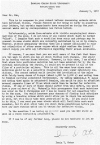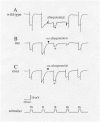Why Drosophila to study phototransduction?
- PMID: 20536286
- PMCID: PMC2923386
- DOI: 10.3109/01677061003797302
Why Drosophila to study phototransduction?
Abstract
This review recounts the early history of Drosophila phototransduction genetics, covering the period between approximately 1966 to 1979. Early in this period, the author felt that there was an urgent need for a new approach in phototransduction research. Through inputs from a number of colleagues, he was led to consider isolating Drosophila mutants that are defective in the electroretinogram. Thanks to the efforts of dedicated associates and technical staff, by the end of this period, he was able to accumulate a large number of such mutants. Particularly important in this effort was the use of the mutant assay protocol based on the "prolonged depolarizing afterpotential." This collection of mutants formed the basis of the subsequent intensive investigations of the Drosophila phototransduction cascade by many investigators.
Figures





Similar articles
-
Drosophila in vision research. The Friedenwald Lecture.Invest Ophthalmol Vis Sci. 1995 Nov;36(12):2340-57. Invest Ophthalmol Vis Sci. 1995. PMID: 7591624 Review.
-
PDA (prolonged depolarizing afterpotential)-defective mutants: the story of nina's and ina's--pinta and santa maria, too.J Neurogenet. 2012 Jun;26(2):216-37. doi: 10.3109/01677063.2011.642430. Epub 2012 Jan 27. J Neurogenet. 2012. PMID: 22283778 Free PMC article. Review.
-
Photoreceptor responses of fruitflies with normal and reduced arrestin content studied by simultaneous measurements of visual pigment fluorescence and ERG.J Comp Physiol A Neuroethol Sens Neural Behav Physiol. 2010 Jan;196(1):23-35. doi: 10.1007/s00359-009-0489-5. Epub 2009 Nov 19. J Comp Physiol A Neuroethol Sens Neural Behav Physiol. 2010. PMID: 19924417 Free PMC article.
-
Effects of a mutation in the Drosophila porin gene encoding mitochondrial voltage-dependent anion channel protein on phototransduction.Dev Neurobiol. 2007 Sep 15;67(11):1533-45. doi: 10.1002/dneu.20526. Dev Neurobiol. 2007. PMID: 17525991
-
Phototransduction in Drosophila.Sci China Life Sci. 2012 Jan;55(1):27-34. doi: 10.1007/s11427-012-4272-4. Epub 2012 Feb 8. Sci China Life Sci. 2012. PMID: 22314488 Review.
Cited by
-
Two novel forms of ERG oscillation in Drosophila: age and activity dependence.J Neurogenet. 2018 Mar-Jun;32(2):118-126. doi: 10.1080/01677063.2018.1461866. Epub 2018 Apr 24. J Neurogenet. 2018. PMID: 29688104 Free PMC article.
-
Drosophila melanogaster rhodopsin Rh7 is a UV-to-visible light sensor with an extraordinarily broad absorption spectrum.Sci Rep. 2017 Aug 4;7(1):7349. doi: 10.1038/s41598-017-07461-9. Sci Rep. 2017. PMID: 28779161 Free PMC article.
-
Drosophila sensory receptors-a set of molecular Swiss Army Knives.Genetics. 2021 Mar 3;217(1):1-34. doi: 10.1093/genetics/iyaa011. Genetics. 2021. PMID: 33683373 Free PMC article. Review.
-
Eye proteome of Drosophila melanogaster.Proteomics. 2024 May;24(10):e2300330. doi: 10.1002/pmic.202300330. Epub 2023 Nov 14. Proteomics. 2024. PMID: 37963819 Free PMC article.
-
Drosophila visual transduction.Trends Neurosci. 2012 Jun;35(6):356-63. doi: 10.1016/j.tins.2012.03.004. Epub 2012 Apr 10. Trends Neurosci. 2012. PMID: 22498302 Free PMC article. Review.
References
-
- Ahmed ST, Joyce MV, Boggess B, O'Tousa JE. The role of Drosophila ninaG oxidoreductase in visual pigment chromophore biogenesis. J. Biol. Chem. 2006;281:9205–9209. - PubMed
-
- Alderson T. Chemically induced delayed germinal mutation in Drosophila. Nature. 1965;207:164–167. - PubMed
-
- Bloomquist BT, Shortridge RD, Schneuwly S, Perdew M, Montell C, Steller H, et al. Isolation of a putative phospholipase C gene of Drosophila, norpA, and its role in phototransduction. Cell. 1988;54(5):723–733. - PubMed
-
- Brady AE, Limbird LE. G protein-coupled receptor interacting proteins: emerging roles in localization and signal transduction. Cell Signal. 2002;14:297–309. - PubMed
Publication types
MeSH terms
Grants and funding
LinkOut - more resources
Full Text Sources
Molecular Biology Databases
